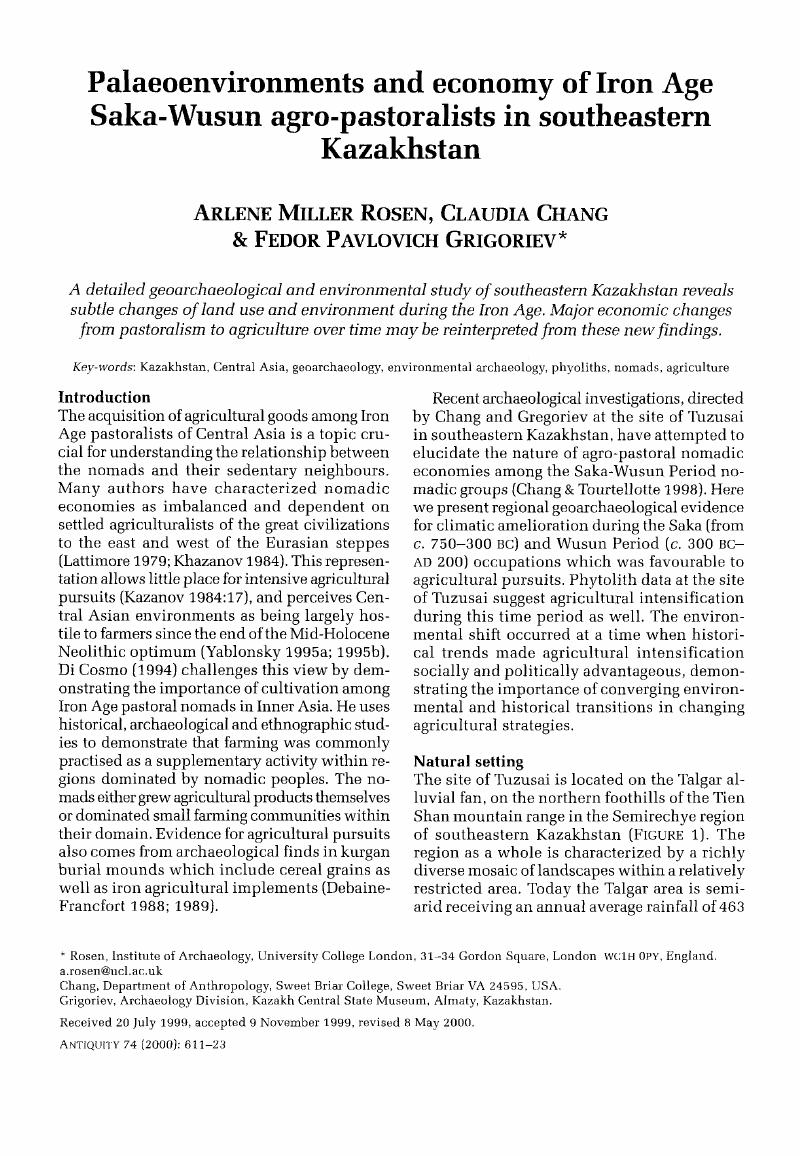Crossref Citations
This article has been cited by the following publications. This list is generated based on data provided by Crossref.
Nixon, Lucia
and
Price, Simon
2001.
The diachronic analysis of pastoralism through comparative variables.
The Annual of the British School at Athens,
Vol. 96,
Issue. ,
p.
395.
Chang, Claudia
Benecke, Norbert
Grigoriev, Fedor P.
Rosen, Arlene M.
and
Tourtellotte, Perry A.
2003.
Iron Age society and chronology in South-east Kazakhstan.
Antiquity,
Vol. 77,
Issue. 296,
p.
298.
Rogers, J. Daniel
Ulambayar, Erdenebat
and
Gallon, Mathew
2005.
Urban centres and the emergence of empires in Eastern Inner Asia.
Antiquity,
Vol. 79,
Issue. 306,
p.
801.
Honeychurch, William
and
Amartuvshin, Chunag
2006.
Archaeology of Asia.
p.
255.
Frachetti, Michael D.
and
Mar'yashev, Alexei N.
2007.
Long-Term Occupation and Seasonal Settlement of Eastern Eurasian Pastoralists at Begash, Kazakhstan.
Journal of Field Archaeology,
Vol. 32,
Issue. 3,
p.
221.
Kealhofer, Lisa
and
Grave, Peter
2008.
Land Use, Political Complexity, and Urbanism in Mainland Southeast Asia.
American Antiquity,
Vol. 73,
Issue. 2,
p.
200.
Frachetti, Michael D.
Spengler, Robert N.
Fritz, Gayle J.
and
Mar'yashev, Alexei N.
2010.
Earliest direct evidence for broomcorn millet and wheat in the central Eurasian steppe region.
Antiquity,
Vol. 84,
Issue. 326,
p.
993.
Hanks, Bryan
2010.
Archaeology of the Eurasian Steppes and Mongolia.
Annual Review of Anthropology,
Vol. 39,
Issue. 1,
p.
469.
Frachetti, Michael D.
2011.
Migration Concepts in Central Eurasian Archaeology.
Annual Review of Anthropology,
Vol. 40,
Issue. 1,
p.
195.
Frachetti, Michael D.
2012.
Multiregional Emergence of Mobile Pastoralism and Nonuniform Institutional Complexity across Eurasia.
Current Anthropology,
Vol. 53,
Issue. 1,
p.
2.
Blättermann, Maik
Frechen, Manfred
Gass, Anton
Hoelzmann, Philipp
Parzinger, Hermann
and
Schütt, Brigitta
2012.
Late Holocene landscape reconstruction in the Land of Seven Rivers, Kazakhstan.
Quaternary International,
Vol. 251,
Issue. ,
p.
42.
Motuzaite-Matuzeviciute, Giedre
Telizhenko, Sergey
and
Jones, Martin K
2012.
Archaeobotanical investigation of two Scythian-Sarmatian period pits in eastern Ukraine: Implications for floodplain cereal cultivation.
Journal of Field Archaeology,
Vol. 37,
Issue. 1,
p.
51.
Spengler, Robert N.
Chang, Claudia
and
Tourtellotte, Perry A.
2013.
Agricultural production in the Central Asian mountains: Tuzusai, Kazakhstan (410–150b.c.).
Journal of Field Archaeology,
Vol. 38,
Issue. 1,
p.
68.
Spengler, Robert N.
and
Willcox, George
2013.
Archaeobotanical results from Sarazm, Tajikistan, an Early Bronze Age Settlement on the edge: Agriculture and exchange.
Environmental Archaeology,
Vol. 18,
Issue. 3,
p.
211.
Murphy, Eileen M.
Schulting, Rick
Beer, Nick
Chistov, Yuri
Kasparov, Alexey
and
Pshenitsyna, Margarita
2013.
Iron Age pastoral nomadism and agriculture in the eastern Eurasian steppe: implications from dental palaeopathology and stable carbon and nitrogen isotopes.
Journal of Archaeological Science,
Vol. 40,
Issue. 5,
p.
2547.
Spengler, Robert N
Frachetti, Michael D.
and
Fritz, Gayle J.
2013.
Ecotopes and Herd Foraging Practices In the Steppe/Mountain Ecotone of Central Asia During the Bronze and Iron Ages.
Journal of Ethnobiology,
Vol. 33,
Issue. 1,
p.
125.
Svyatko, Svetlana V.
Schulting, Rick J.
Mallory, James
Murphy, Eileen M.
Reimer, Paula J.
Khartanovich, Valeriy I.
Chistov, Yury K.
and
Sablin, Mikhail V.
2013.
Stable isotope dietary analysis of prehistoric populations from the Minusinsk Basin, Southern Siberia, Russia: a new chronological framework for the introduction of millet to the eastern Eurasian steppe.
Journal of Archaeological Science,
Vol. 40,
Issue. 11,
p.
3936.
Linduff, Katheryn M.
2014.
Immortals in a foreign land: the Kargaly diadem.
Antiquity,
Vol. 88,
Issue. 339,
p.
160.
Heinsch, MaryFran
Vandiver, Pamela B.
Lyublyanovics, Kyra
Choyke, Alice M.
Tourtellotte, Perry
and
Chang, Claudia
2014.
Ceramics at the Emergence of the Silk Road: A Case from Southeastern Kazakhstan.
MRS Proceedings,
Vol. 1656,
Issue. ,
Spengler, Robert N.
2014.
Niche Dwelling vs. Niche Construction: Landscape Modification in the Bronze and Iron Ages of Central Asia.
Human Ecology,
Vol. 42,
Issue. 6,
p.
813.



